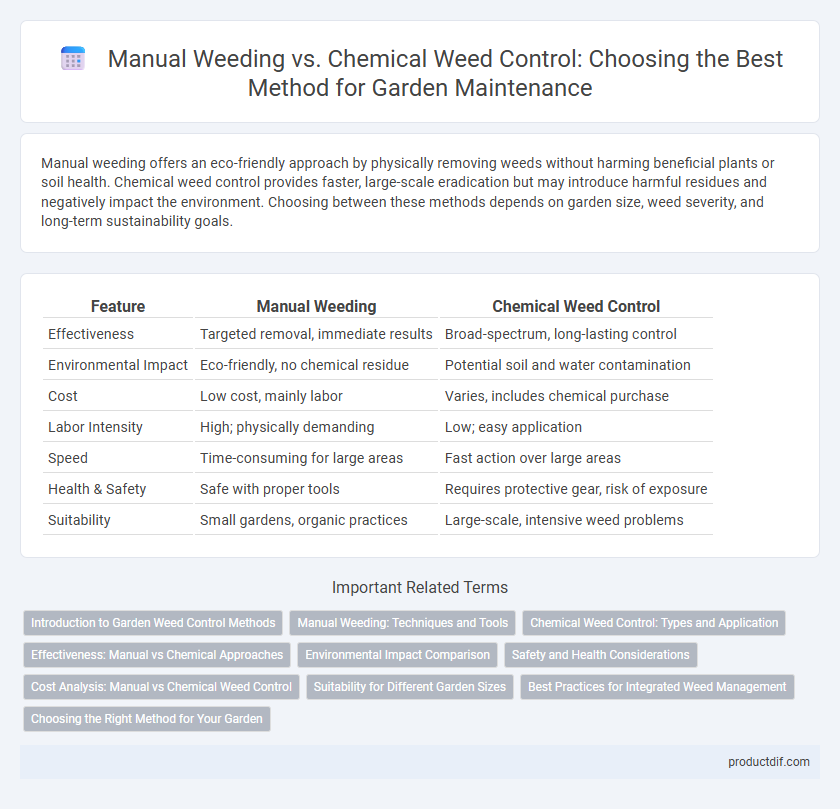Manual weeding offers an eco-friendly approach by physically removing weeds without harming beneficial plants or soil health. Chemical weed control provides faster, large-scale eradication but may introduce harmful residues and negatively impact the environment. Choosing between these methods depends on garden size, weed severity, and long-term sustainability goals.
Table of Comparison
| Feature | Manual Weeding | Chemical Weed Control |
|---|---|---|
| Effectiveness | Targeted removal, immediate results | Broad-spectrum, long-lasting control |
| Environmental Impact | Eco-friendly, no chemical residue | Potential soil and water contamination |
| Cost | Low cost, mainly labor | Varies, includes chemical purchase |
| Labor Intensity | High; physically demanding | Low; easy application |
| Speed | Time-consuming for large areas | Fast action over large areas |
| Health & Safety | Safe with proper tools | Requires protective gear, risk of exposure |
| Suitability | Small gardens, organic practices | Large-scale, intensive weed problems |
Introduction to Garden Weed Control Methods
Manual weeding involves physically removing weeds by hand or with tools, ensuring minimal environmental impact and preserving soil health. Chemical weed control uses herbicides to target and eliminate weeds quickly, offering efficiency but requiring careful application to avoid damage to desired plants. Selecting the appropriate garden weed control method depends on the garden size, weed severity, and environmental considerations.
Manual Weeding: Techniques and Tools
Manual weeding employs techniques such as hand-pulling, hoeing, and digging to remove weeds effectively from garden beds and pathways. Essential tools for manual weeding include hand trowels, hoes, weed pullers, and cultivators, which enhance precision and reduce soil disturbance. This approach preserves beneficial soil microorganisms and avoids the chemical residues associated with herbicides, promoting healthier garden ecosystems.
Chemical Weed Control: Types and Application
Chemical weed control methods include selective herbicides, which target specific weed species without harming desirable plants, and non-selective herbicides, which eliminate all vegetation in treated areas. Application techniques such as foliar spraying, soil treatment, and pre-emergent herbicide application optimize weed management by affecting weed growth at different stages. Proper chemical selection based on weed species and timing ensures effective control while minimizing environmental impact and promoting garden health.
Effectiveness: Manual vs Chemical Approaches
Manual weeding offers precise control by physically removing weeds, ensuring minimal impact on surrounding plants and soil health, but it can be labor-intensive and time-consuming for large areas. Chemical weed control provides rapid and broad-spectrum effectiveness, efficiently targeting various weed species and reducing regrowth with fewer labor demands, though it may pose risks to beneficial plants and soil ecosystems. Combining both methods strategically can optimize weed management by balancing immediate results with environmental sustainability.
Environmental Impact Comparison
Manual weeding minimizes environmental harm by avoiding chemical runoff that contaminates soil and water, preserving beneficial insects and microorganisms. Chemical weed control often introduces toxins that can disrupt local ecosystems, reduce biodiversity, and contribute to soil degradation. Choosing manual weeding supports sustainable gardening practices and helps maintain ecological balance in garden supply management.
Safety and Health Considerations
Manual weeding eliminates exposure to toxic herbicides, making it a safer option for gardeners and pets by reducing risks of skin irritation and respiratory problems. Chemical weed control, while effective and time-saving, may introduce harmful chemicals that can contaminate soil and water, posing long-term health risks. Prioritizing protective gear and selecting eco-friendly products can mitigate some dangers associated with chemical treatments.
Cost Analysis: Manual vs Chemical Weed Control
Manual weeding requires a higher labor investment but incurs minimal material costs, making it cost-effective for small gardens or low-density weed areas. Chemical weed control involves upfront expenses for herbicides and application equipment, yet it can save significant time and labor, proving economical for large-scale or heavy infestations. Evaluating long-term costs reveals that manual weeding may increase labor expenses, whereas chemical methods might lead to recurring purchase costs and potential environmental mitigation expenses.
Suitability for Different Garden Sizes
Manual weeding is highly suitable for small to medium-sized gardens, offering precise control without the risk of chemical exposure, making it ideal for home gardeners with limited spaces. Chemical weed control becomes more practical for larger garden areas or commercial landscaping, where speed and efficiency in managing extensive weed growth are essential. Choosing between these methods depends on garden size, accessibility, and the gardener's preference for organic versus chemical solutions.
Best Practices for Integrated Weed Management
Manual weeding preserves soil health by avoiding chemical residues, making it ideal for small gardens and organic practices. Chemical weed control offers quick and broad-spectrum weed suppression but requires careful application to minimize environmental impact and prevent herbicide resistance. Combining manual removal with targeted herbicide use supports sustainable integrated weed management by optimizing weed control efficacy while protecting beneficial soil organisms.
Choosing the Right Method for Your Garden
Manual weeding provides precise removal of unwanted plants without introducing harmful substances, making it ideal for organic gardens and small spaces. Chemical weed control offers faster results for large areas but requires careful selection of herbicides to avoid damage to desirable plants and soil health. Assessing your garden size, plant types, and environmental impact helps determine the most effective and sustainable weed management strategy.
Manual Weeding vs Chemical Weed Control Infographic

 productdif.com
productdif.com